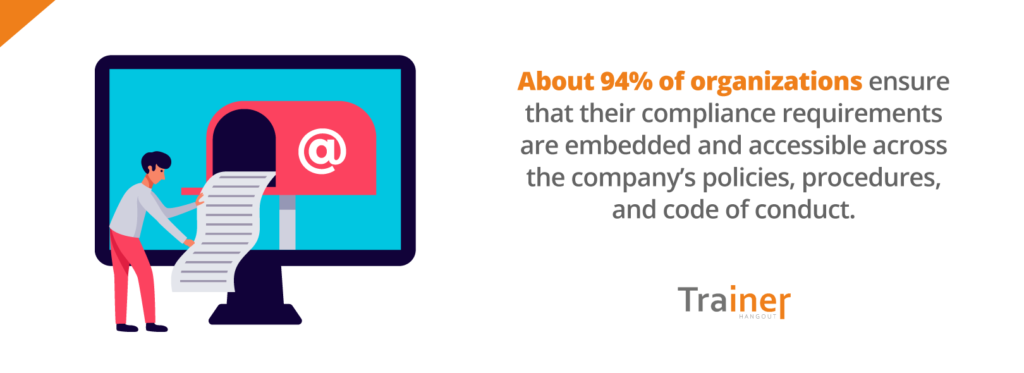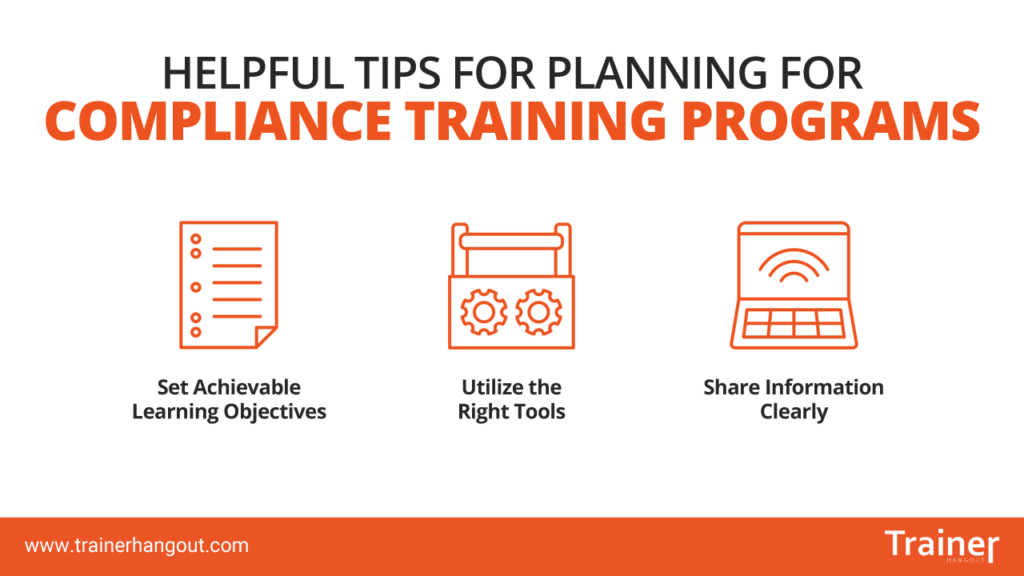88% of organizations don’t onboard employees well. According to a study by Gallup, only 12% of employees are satisfied with how their companies onboard employees.
Proper onboarding is critical to the employees, and most especially, to the company. Without a reliable onboarding process, your company will most likely experience a problematic retention and productivity rate. A huge part of the reason why your onboarding process affects your employees and your company, in general, is because much of how your employees will value their work, and the rules and regulations of the company rely heavily on the compliance training they get during onboarding.
About 94% of organizations make sure that their compliance requirements are embedded and accessible across the company’s policies, procedures, and code of conduct. This makes an even stronger case for compliance training programs to be conducted during the onboarding stage. Compliance training is also important at any stage of employment on an ongoing basis. 29% of organizations do this by making sure that they assess their employees’ compliance proficiencies and skills regularly.

Understanding the Importance of Compliance Training
Through the organization’s compliance training, employees get oriented with the following important information about the company:
- Regulations
- Policies
- Law Adherence
- Standard Operating Procedures
These are the specific information about the company that every employee is mandated to know. Failure to share these pieces of information with the employees can result in a great loss on the company’s side.
Most companies do not allow their new hires to proceed with employment unless they go through compliance training. This only speaks about the value that this type of training brings to the company and its overall success.
Let’s discuss further the specific benefits of compliance training.
Benefits of Compliance Training
Compliance training programs may differ in content and conduct but they are generally the same in terms of the benefits they bring.
An effective compliance training achieves several benefits for the company and the employees. Here are some benefits of compliance training.
Awareness Among Employees
Compliance training seeks to let employees be aware of the different regulations they must observe to ensure further safety of the workplace and employees. Having compliance training will ensure the employees to be observant with the necessary skills and strategies they must employ in different situations that could put their task or safety at risk. Through compliance training, will let the employees be aware of certain things they must observe as they go along on their respective journeys. Informing employees regarding workplace safety is among the examples of giving further awareness among employees.
Better Work Quality
Certain workplaces advocate for further transparency in keeping tasks up to date while establishing further trust and efficiency; thus, making sure to have better work quality. Compliance training will let employees still achieve the necessary targets they must hit in efficiently achieving the different workplace goals. Compliance training facilitates these targets among employees by means of conducting training sessions that concretize how the employees must make sure that they get to have better work quality in terms of the different aspects that the company must look up into.
Increased Work Productivity
Through compliance training, will boost the increased work productivity in a certain company given that every major or minor operation in a certain workplace for a period entails certain measures that must be observed in attaining a task. This can be done through compliance training by means of letting employees observe the necessary measures while executing a major or minor task. Compliance training must include strategies that can ensure the increase in work productivity without compromising the regulations and laws in the workplace.
Risk Management
Legal, environmental, social, and economic risks bring a drastic impact on any organization. Compliance training mitigates different risks that are present in a certain workplace through risk management. To further ensure that risks are effectively managed through compliance training, make sure to mitigate several risks in accordance to the policies of a certain organization. Thorough focus group discussions and compliance training must be conducted in order to make sure that it is in accordance with the overall policies and goals of a certain organization.
Knowledge Sharing
Technically, compliance training facilitates the necessary responses that a certain organization should do to combat the necessary concerns present in the organization. Through collaborative ways of sharing different pieces of knowledge, compliance training lets the employees innovate different pieces of knowledge to effectively address the different problems in the workplace. This will pave the way for increasing client satisfaction and organizational strength in the organization.
Sustainability
Compliance training typically costs over $1.6 million a year depending on a certain degree of compliance training that will be facilitated among employees; thus, making it expensive.
Subsequently, one advantage of compliance training is that it is sustainable. Making sure that compliance training is conducting initiatives in accordance with the policies and goals of the organization, will let different organizations formulate further plans to strengthen the organization’s goals and policies. After the compliance training, maybe organizations can initiate a long-range planning activity where they get to craft plans to further achieve the goals and policies of the organization.
If employees are well-informed about the risks involved in their work and just what policies to follow in order to keep work integrity and avoid legal repercussions, the company can save a lot of time and money, while enabling the employees to become confident as workers and safe physically and legally.
Focuses on Compliance Training
Compliance training programs for different industries often vary according to the goals of the company and the field requirements.
Some of the most popular focuses of compliance training include, but do not limit to the following:
- HR Compliance training
- Cybersecurity training
- Occupational health and safety training
- Data protection & privacy training
- Anti-Discrimination training
- Workplace harassment training
- Regulatory compliance training
- Environmental compliance training
- Employee performance training
Each of these focus areas has different purposes, but they are all concerned with training the employees on the do’s and don’t of the company.
Helpful Tips for Planning for Compliance Training Programs
Running compliance training programs is a huge responsibility.
You want your team to collaborate and plan adequately for the program by setting achievable objectives, utilizing the right tools, and making sure that information is shared clearly.

1. Set Achievable Learning Objectives
The learning objectives prepare the way for all the other steps in a compliance training program checklist.
The learning objectives have to be achievable because there are other learning objectives that are just too ideal and inappropriate for the needs of the company. There are also learning objectives that don’t address a problem.
2. Utilize the right tools
The presentation tools that you will be using also matter. You want to use tools that are able to showcase your lessons in a less cluttered way, while still ensuring that the entire content is engaging.
You can also use digital technology, or check whether there are learning systems that you can adopt so your compliance training can be accessed online for many.
3. Share information clearly
Avoid causing any confusion by using too much technical jargon.
Compliance training lessons are meant to be understood and applied as soon as possible so anything that can potentially confuse an employee will keep that employee from performing his best.
Major Steps in Running Compliance Training Programs
Have you already identified the regulations that your company needs to update your train your employees on? If so, then the next steps that you must take should be all about satisfying that particular need for successful compliance training.
First, look for online resources that you can use for your company. Make sure that if these resources are somebody else’s content, you tag and ask permission
Seck d, choose which delivery mode is the most favorable for your company and for the employees. Most of the training courses these days make use of a Learning Management System. This system banks on providing courses online so trainees can be trained at their own pace, and even give an option for after-work hours.
Lastly, your compliance training program has to be reevaluated again and again. Some content areas may need an update as most of the information may no longer be applicable now.
In the same way, you must track your participant’s progress and ensure that they are able to complete each lesson at a given time. Otherwise, it defeats one of the purposes of compliance training which is to equip employees before they start with their actual work, or as they level up in their positions.
Document your training strategies and the techniques you’ve tried. This will definitely help tweak your compliance training program in the future, as well as avoid spending more time on planning when there is more to learn from the actual execution. Documentation will also help the rest of the team stay informed about any changes and be able to give proper recommendations for improvement.
Compliance training programs must be able to look after all the stakeholders of the organization, not just the company in itself. If you can’t secure this one important element across all your compliance training sessions, then you may face out-of-hand challenges.




